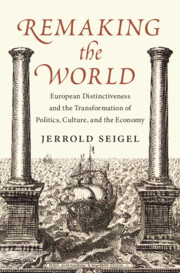 Remaking the World
Remaking the World from Part II - Autonomy and Teleocracy
Published online by Cambridge University Press: 29 November 2024
Although no direct claim for the autonomy of spheres was advanced in the scholastic speculations discussed in Chapter 5, such notions would be put forward in the circles where humanism and the artistic renewal pursued in contact with it emerged in Renaissance Italy. A powerful example was Giorgio Vasari’s assertion that what caused art and architecture to decline from its ancient heights was the substitution of religious values for aesthetic ones by Christianity as it became established under the Roman Empire. This defense of aesthetic autonomy would become more general and explicit as the expansion of the audience for painting and sculpture and the display of art objects in locations specifically dedicated to them – museums and galleries instead of churches or princely and noble residences – confronted viewers with “art as such,” and it would be theorized in Kant’s aesthetics at the end of the eighteenth century, which removed both religious and social value from judgments about art. But this development was singularly European. No similar move toward attributing autonomy to the aesthetic sphere would take place in India, China, or Muslim territories, despite the many beautiful objects produced in all of them and the exalted position attributed to artists in some.
To save this book to your Kindle, first ensure [email protected] is added to your Approved Personal Document E-mail List under your Personal Document Settings on the Manage Your Content and Devices page of your Amazon account. Then enter the ‘name’ part of your Kindle email address below. Find out more about saving to your Kindle.
Note you can select to save to either the @free.kindle.com or @kindle.com variations. ‘@free.kindle.com’ emails are free but can only be saved to your device when it is connected to wi-fi. ‘@kindle.com’ emails can be delivered even when you are not connected to wi-fi, but note that service fees apply.
Find out more about the Kindle Personal Document Service.
To save content items to your account, please confirm that you agree to abide by our usage policies. If this is the first time you use this feature, you will be asked to authorise Cambridge Core to connect with your account. Find out more about saving content to Dropbox.
To save content items to your account, please confirm that you agree to abide by our usage policies. If this is the first time you use this feature, you will be asked to authorise Cambridge Core to connect with your account. Find out more about saving content to Google Drive.